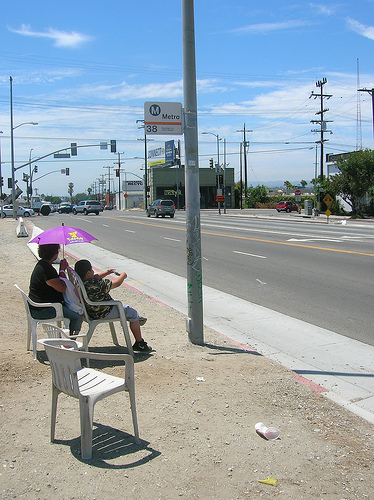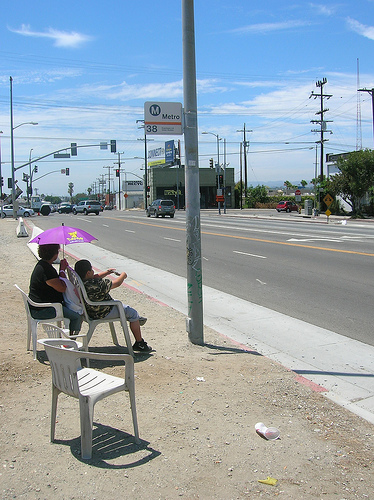 Is Los Angeles leaving its transit riders in the dust?Photo: Fred CaminoNo mode of transport in this country gets more disrespect than buses. Also low in the pecking order in this country? Women, immigrants, and domestic workers.
Is Los Angeles leaving its transit riders in the dust?Photo: Fred CaminoNo mode of transport in this country gets more disrespect than buses. Also low in the pecking order in this country? Women, immigrants, and domestic workers.
So maybe it’s no surprise that a Los Angeles bus line primarily used by women immigrant domestic workers is being cut by the city’s transportation agency.
A New York Times article by Jennifer Medina that ran over the holiday weekend (hardly journalistic prime time) told the story of the people who ride the 305 bus — and who, come fall, will have to find a new way to get to work.
Winding northwest through the Angeleno sprawl from the low-income neighborhood of Watts to the upscale enclaves of Beverly Hills and Westwood, the 305 follows a natural route. It’s a “desire line” of sorts, as urban observers would have it, for the mostly Latino men and women who work cleaning the mansions and tending to the gardens of the city’s richest citizens.
Not only is it a way to get to work, the 305 has become a community, with many of its riders regularly riding together, sharing conversation, news, and advice. There’s a nice slideshow on the Times site that shows what the scene is like.
According to the Los Angeles County Metropolitan Transit Authority (Metro), there were 1,187,869 bus boardings in Los Angeles County on an average weekday in May 2011. Pretty impressive, right? But the financially beleaguered agency has systematically cut bus service over the past few years, putting new emphasis on building rail lines.
The history behind the city’s patchwork of bus lines has been contentious for years. From the Times story:
The fight over the city’s buses stretches back decades. In 1996, advocacy organizations filed a civil rights lawsuit saying the transportation authority had not done enough to keep its fares low or prevent overcrowding. A consent decree mandated federal oversight for the next decade and required the system to spend $1 billion to add new lines and more buses on existing routes. But that oversight expired in 2006, and the Bus Riders Union filed a complaint that helped prompt an investigation of the agency that is scheduled to begin this month.
The 305 was one of several lines created under the consent decree, and it is the only direct route from the city’s impoverished southern neighborhoods to its affluent West Side, where legions of janitors, nannies and maids work each day.
Now it’s slated for the chopping block, to be eliminated in the fall, in favor of a “hub and spoke” arrangement which, according to Metro officials quoted in the Times story, will lead to greater efficiency.
“We want to fill in the grid rather than rely on these customized zigzagging lines,” said Conan Cheung, the transit authority’s deputy executive officer for service planning. “We have to streamline the system to work for the highest number of people.”
But the Bus Riders Union complains that the transit agency continues to treat the bus lines as a “separate and unequal system.” Under the new system, the 3,000 passengers who board the 305 each day, paying $1.50 for each trip, will instead have to take a series of buses or trains that could take twice as long and cost three times as much. (Unlike other cities, the patchwork system in Los Angeles does not allow free transfers.)
This is part of a huge round of cuts to the bus system that began in the spring — cuts that disproportionately affected poor people, as LA Weekly pointed out. Officials at Metro hold up expanded rail service as a solution (the 305 bus will be eliminated only after a new light rail line is opened).
Transit-planning consultant Jarrett Walker, who blogs at Human Transit, wrote a post criticizing the Times article, saying that it ignored the principles of what makes for a good system in favor of the compelling narrative of a single line and the people who ride it. Walker acknowledged the symbolic significance of the 305 line, but said that is no reason to save it — on the contrary:
Symbolically, the 305 links the “poor south” and the “affluent west,” and thus helps everyone feel good about having served domestic workers. In fact, the 305 runs through a small part of the vast “poor south” and a small part of the vast “affluent west,” but it’s still useless for most of the people making that kind of trip, because both areas are so large that no one bus line, or even five, could link all of the likely origin-destination pairs between them….
This problem is why frequency and connections were invented. The governing principle of transit in these core parts of Los Angeles is the high-frequency grid, which allows everywhere-to-everywhere travel at high frequencies with at most one connection. Yes, it may be sad that some domestic workers who are used to zero-transfer trips are now going to have a one-transfer trip, but that only means that 305 riders will have the same level of transit mobility that everyone else has, including most domestic workers. It also means that Los Angeles transit will be treating all of this demographic equally, rather than arbitrarily preferring people whose path happens to lie along Line 305.
The other moral of this story is even simpler: If your mission is to serve a whole city or region, designing transit routes around any self-identified group of people is almost always a bad idea. Most successful and attractive transit seeks maximum versatility, by serving the most diverse possible range of demographics, trip purposes, and origin-destination pairs. You can make exceptions where a single demographic group produces sufficiently massive ridership, as in some commute markets. But in general, the way people self-organize and self-identify politically is a bad guide to how to meet their transit needs efficiently. Everyone can draw the perfect transit line just for their interest group, but such proposals tell you nothing about what a good transit system would look like.
I talked to Sunyoung Yang, lead organizer of the Bus Riders Union, about Walker’s critique. She told me that what she sees in Metro’s planning is not the building of a more efficient grid, but the diversion of already scarce transit funding from buses to rail. The 305 is just one of many instances of cuts to bus service, she said, and overall, the city has eliminated almost a million hours of bus service since the consent decree expired in 2006 (Metro did not respond to a request for comment).
“T
hey’ve cut some key lifelines,” Yang told me.
She said that the emphasis on rail is about money. “Transit planning in L.A. is not about meeting people’s needs,” she said. “It’s about corporate contracts. It’s about transit-oriented developers, construction companies, and contractors who are banking on these contracts for the next 30 years.”
In Yang’s view the city’s rail expansion plan is overambitious and unsustainable — and it can’t in the short term serve the needs of the county’s half-million transit riders (16.53 percent of L.A. city residents didn’t own a car in the 2000 census). And without integrated fare payment and transfers, the financial burden on people who are already working at low-paying jobs quickly can become unsustainable. Walking two or three blocks to make those transfers, sometiems twice in a trip, can also be a hardship for the elderly and those who do hard physical labor.
“It’s not OK to build on the backs of poor people and cannibalize existing service,” she said.
This isn’t just an L.A. problem. All around the country, public transit budgets are shrinking, fares are going up, and service is being slashed. It’s an ugly situation. In an ideal scenario, there would be money for both buses and rail. But as long as the automobile is prioritized by lawmakers at the federal and state levels, the pool of transit dollars will be inadequate, and advocates for different modes will be pitted against each other.
Back in December of 1955, the Montgomery bus boycott began. It was perhaps the most famous instance of the intersection of public transit and social justice. But as Angela Glover Blackwell of PolicyLink pointed out to me in an interview last fall, access to transportation was a civil rights issue before Rosa Parks refused to move to the back of the bus, and it continues to be so today.
What we have to remember is that the majority of people who use public transportation in this nation are people of color, low-income people. That is what keeps our system going. If we are going to begin to invest in it, we need to invest in it leading with equity, asking, How do we build modern public transportation systems that serve those people who have been the backbone of utilizing public transportation? Who need it not because it’s the smart thing to do, but [because] it’s the only thing for them to do in order to stretch their dollars and respond to their reality of not having a car?
This notion that public transit is [only] for the affluent who are looking for a different lifestyle is a false notion.
Glover’s words seem more relevant than ever. Transit systems need better, more stable funding sources, or the U.S. economy is going to get left behind.



